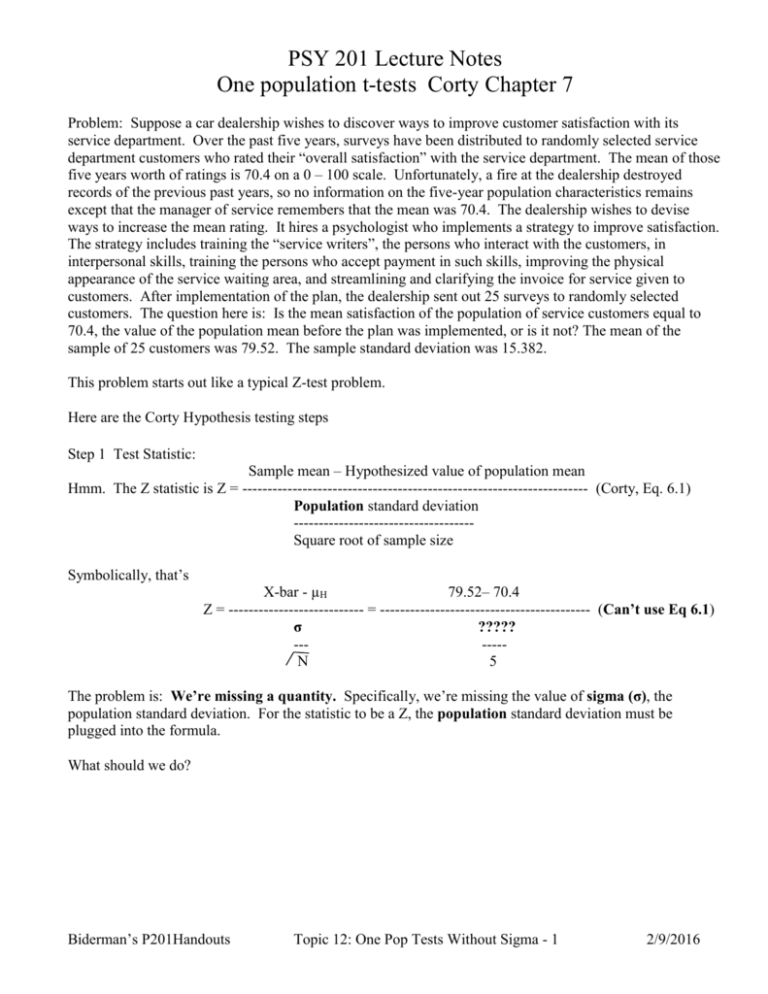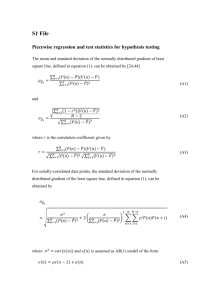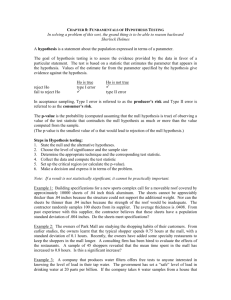Psychology 2010 Lecture 11 Notes: Single
advertisement

PSY 201 Lecture Notes One population t-tests Corty Chapter 7 Problem: Suppose a car dealership wishes to discover ways to improve customer satisfaction with its service department. Over the past five years, surveys have been distributed to randomly selected service department customers who rated their “overall satisfaction” with the service department. The mean of those five years worth of ratings is 70.4 on a 0 – 100 scale. Unfortunately, a fire at the dealership destroyed records of the previous past years, so no information on the five-year population characteristics remains except that the manager of service remembers that the mean was 70.4. The dealership wishes to devise ways to increase the mean rating. It hires a psychologist who implements a strategy to improve satisfaction. The strategy includes training the “service writers”, the persons who interact with the customers, in interpersonal skills, training the persons who accept payment in such skills, improving the physical appearance of the service waiting area, and streamlining and clarifying the invoice for service given to customers. After implementation of the plan, the dealership sent out 25 surveys to randomly selected customers. The question here is: Is the mean satisfaction of the population of service customers equal to 70.4, the value of the population mean before the plan was implemented, or is it not? The mean of the sample of 25 customers was 79.52. The sample standard deviation was 15.382. This problem starts out like a typical Z-test problem. Here are the Corty Hypothesis testing steps Step 1 Test Statistic: Sample mean – Hypothesized value of population mean Hmm. The Z statistic is Z = --------------------------------------------------------------------- (Corty, Eq. 6.1) Population standard deviation -----------------------------------Square root of sample size Symbolically, that’s X-bar - µH 79.52– 70.4 Z = --------------------------- = ------------------------------------------ (Can’t use Eq 6.1) σ ????? ------N 5 The problem is: We’re missing a quantity. Specifically, we’re missing the value of sigma (σ), the population standard deviation. For the statistic to be a Z, the population standard deviation must be plugged into the formula. What should we do? Biderman’s P201Handouts Topic 12: One Pop Tests Without Sigma - 1 2/9/2016 The test statistic problem This problem was faced by statisticians of old (who would now be very old statisticians.) They wanted to compute a Z statistic but did not know the value of the population standard deviation. In fact, this is the situation we’ll most likely face. If we’re so ignorant of the characteristics of a population that we don’t know its mean, how in earth could we know its standard deviation? The answer is: We couldn’t. We need to find a way of testing such hypotheses without having to know the value of the population standard deviation. Why do we even care? We care because we can’t determine the p-value necessary for making a decision. The determination of the p-value depends on the use of the Normal Distribution tables. But if we don’t have a Z statistic, we can’t use the Normal Distribution tables. Two possible solutions Solution 1: Take a large sample and use the sample standard deviation as a substitute for the population standard deviation. This is what statisticians of old did in the early 1900s. They took samples of 200+, used the sample standard deviation in place of the population standard deviation in the formula, and pretended that they had a Z statistic. They then used the Normal distribution tables to determine p-values. This procedure was technically incorrect, since the number they put in the Z-statistic formula was NOT the actual population standard deviation but a sample quantity. But since the sample sizes they used were very large, the value they substituted was probably quite close to the true value, and they probably computed p-values that were very close to the correct ones. So why not just keep on doing this – taking huge samples and pretending the statistic is a Z. a. Huge samples cost a lot in terms of $ and time. b. It just isn’t right. Biderman’s P201Handouts Topic 12: One Pop Tests Without Sigma - 2 2/9/2016 Solution 2. Figure out the correct sampling distribution of the statistic X-bar - µH ? = ---------------------------------------S --N Note that the formula has S, rather than σ in the denominator. Note also that it’s not called Z, it’s called “?” because we don’t know what it is. The computations necessary for Solution 2 were provided by a mathematician named William Gosset in the early 1900s. He figured out what the sampling distribution of the above quantity was. Gosset called the distribution the T distribution. He called the statistic the t statistic. The Z and the T distributions are pictured below. Note first that they’re pretty similar. But careful inspection shows a difference: The T distribution is more variable than the Z. The probability of a Z close to 5, for example is essentially 0. But the probability of a t of 5 is substantial, as can be seen from the height of the curve near 5. Z T -5 Biderman’s P201Handouts 0 5 Topic 12: One Pop Tests Without Sigma - 3 2/9/2016 Degrees of freedom and variability of the T distribution The T distribution is different from the Normal distribution in one other respect. Its variability changes as sample size changes. Part of the formula for T distribution is the quantity, N-1. This value is called degrees of freedom. It is a parameter in the T distribution, just as п and e are parameters of the Normal distribution. In general, degrees of freedom, symbolized as df, equals N-1 for a single sample. Getting back to the T distribution, as degrees of freedom increases, the variability of the T distribution gets smaller. When degrees of freedom is very large, the T distribution looks more and more like, you guessed it, the Normal Distribution. This validates the practice of the statisticians of old in using large samples to estimate σ. From Steinberg, p. 201 N=5 Gosset’s publication of his result. Two versions of the story . . . 1. Version 1. Gosset was a student of R. A. Fisher, a mathematical genius, and didn’t want to appear to be usurping Fisher’s “territory” with this result. Out of deference to Fisher, the article describing the results concerning the t statistic was published under the pseudonym, Student. The statistic has since been known as Student’s t. 2. Version 2. Gosset worked for a brewery. The brewery did not want it known that its employees were conducting hypothesis tests. That’s because you’re admitting ignorance when you conduct hypothesis tests. For that reason, the article was published anonymously. Biderman’s P201Handouts Topic 12: One Pop Tests Without Sigma - 4 2/9/2016 Critical t values Since the T distribution is more variable than Z, we would expect t values to be farther from 0 than Z values when the null hypothesis is true. Recall that a Z of 1.96 or larger would be unusual if the null were true. But a t of 1.96 would not necessarily be so unusual. Gosset’s calculations allowed statisticians to compute the true p-values associated with various values of t. The formula he derived or one like it is used by all computer programs to compute p-values when t is used as the test statistic. Because the computation of p-values for t is so complicated, prior to the use of computers, statistics textbooks published tables of critical t values – the values of t whose p-values are exactly equal to .05, .01 and other common significance levels. A portion of the t Table from Corty . . . If sample size were equal to 2, a t-value of 12.706 or larger would be required to reject the null. If sample size were equal to 11, a t-value of 2.2281 or larger would be required to reject the null. This is all nice to know, but in the modern age, it’s only useful if you’re stranded on a deserted island. In all other instances, our computer program will compute the p-value associated with the t. Biderman’s P201Handouts Topic 12: One Pop Tests Without Sigma - 5 2/9/2016 Worked Out Example Data (The 25 survey responses from the problem described above were as follows . . .) 1. Find a computer with SPSS on it. 2. Run SPSS . . . Click on Start button -> All Programs -> IBM SPSS Statistics -> IBM SPSS Statistics 22 3. Enter the data and give the column of entries a name, e.g., “rating”. Biderman’s P201Handouts Topic 12: One Pop Tests Without Sigma - 6 2/9/2016 4. Menu Sequence in SPSS . . . Analyze -> Compare Means -> One-Sample T Test... 5. Talk to the t-test procedure Put the name of the variable to be analyzed into the “Test Variable(s)” field. You MUST put the hypothesized value of the population mean in the [Test Value] box. If you don’t, the t value computed by SPSS will be HORRIBLY wrong. Spoiler alert: Someone will forget to put the hypothesized value of the population mean into the Test Value field. That person will lose 1 point because his/her answer will be completely incorrect. Biderman’s P201Handouts Topic 12: One Pop Tests Without Sigma - 7 2/9/2016 The Output of the SPSS t Test procedure T-Test One-Sa mple Statistics N rat ing Rating of New Se rice P roce dure Me an 25 Std . Deviatio n Std . Erro r Me an 79 .52 15 .384 3.0 77 One-Sa mple Test Te st Va lue = 70.4 95 % Co nfide nce I nterv al of the Diffe renc e t rat ing Rating of New Se rice P roce dure df 2.9 64 Sig . (2-t ailed ) Me an Differe nce 24 .00 7 9.1 20 Lo wer Up per 2.7 7 15 .47 All SPSS procedures that conduct hypothesis tests print the p-value for the test. Alas, the p-value is called “Sig.” in SPSS. We have to remember that it’s what we’re calling the p-value. SPSS computes a confidence interval for the population mean. However, the interval is in deviation from the hypothesized mean. To make it more useable, add the Test Value to each limit. (Yes – the test value.) Actual lower limit = “Lower” + Test Value = 2.77 + 70.4 = 73.17 Actual upper limit = “Upper” + Test Value = 15.47 + 70.4 = 85.87 Conclusions Hypothesis test conclusion The p-value is less than .05 so “We reject the hypothesis that the mean of the population of ratings equals 70.4.” Confidence interval conclusion Lower limit = Test value + Lower = 70.4 + 2.77 = 73.17 Upper limit = Test value + Upper = 70.4 + 15.47 = 85.87 The probability is .95 that the interval 73.17 and 85.87 surrounds the population mean. (-------------------------------M------------------------------) ...|....|....|....|....|....|....|....|....|....|....|....|....|....|....|....| 72 73 74 75 76 77 78 79 80 81 82 83 84 85 86 87 Biderman’s P201Handouts Topic 12: One Pop Tests Without Sigma - 8 2/9/2016 Example problem II Suppose a manufacturer of radial tires claims that the average mileage of its tires is 40,000 miles. To test the claim, you purchase 9 of the tires and run them until their tread reaches the minimum legal depth. The number of miles for each of the tires is 36900, 33300, 35500, 32000, 37800, 40000, 43200, 39500, and 34900. Set up and test the appropriate hypothesis. SPSS Computations for Tire Mileage Example Problem Be sure to put the hypothesized value of the population mean in the “Test Value” field. T-Test One-Sample Statistics N miles Mean 9 Std. Deviation 37011.11 Std. Error Mean 3530.030 1176.677 One-Sample Test Test Value = 40000 95% Confidence Interval of the Difference t miles df -2.540 Sig. (2-tailed) 8 .035 Mean Difference -2988.889 Lower Upper -5702.31 -275.47 To form the 95% confidence interval, add the test value to the value under Lower and to the value under Upper. So the 95% confidence interval is Lower Limit = 40,000 – 5702.31 = 34,297.69 Upper Limit = 40,000 – 275.47 = 39,724.53. Biderman’s P201Handouts Topic 12: One Pop Tests Without Sigma - 9 2/9/2016 The Hypothesis Testing Answer sheet. This is the sheet you’ll be expected to fill out for each hypothesis testing problem. 1. Give the name and the formula of the test statistic that will be employed to test the null hypothesis. One sample t statistic because we don’t know the value of the population standard deviation. If we did know the value of the population SD, we’d use the Z statistic. (X-bar – 40000) One sample t = -----------------------------/ S --9 2. Check the assumptions: I looked at the distribution of mileages in the sample. It appears to be OK. 3. The null and alternative hypotheses. Population mean = 40000. Null Hypothesis:______________________________________________________ Formally state the Population mean <> 40000. Alternative Hypothesis:_______________________ ______________________________ 4. What significance level will you use to separate "likely" value from "unlikely" values of the test statistic? .05 Hint: .05 is a popular choice.___________________________________________________________ 5. What is the value of the test statistic computed from your data and the p-value? The value of the t is 2.540. The p-value is .035. ___________________________________________________________________________ What is your conclusion? Do you reject or not reject the null hypothesis? Reject Null Hypothesis. What are the upper and lower limits of a 95% confidence interval appropriate for the problem? Present them in a sentence. The probability is .95 that the interval, 34,298 to 39,725 contains the population mean. State the implications of your conclusion for the problem you were asked to solve. That is, relate your statistical conclusion to the problem. It appears that the manufacturer’s claim is incorrect. Our evidence suggests that the population mean is less than 40,000, somewhere between 34,298 and 39,725. Biderman’s P201Handouts Topic 12: One Pop Tests Without Sigma - 10 2/9/2016 Effect Size In the above example, the mean of the sample of 9 tire lifetimes was 37,011 miles. This value was significantly different from the hypothesized value of 40,000. But you might wonder how different the sample value was from the hypothesized value in “statistical” distance. Data analysts have a way of answering that question. It involves computation of what is called the effect size of the difference. For a one population problem, effect size is (Sample Mean – Hypothesized mean) / Sample SD Sample mean – Hypothesized Mean Effect Size = -------------------------------------------------Sample Standard Deviation For the above problem . . . 37,011.111 – 40,000 -2988.89 Effect Size = ---------------------------------- = -------------------------------- = - .85 3,530.029 3530.029 Data analysts sometimes use the following guidelines to judge how “big” an effect is . . . Small: Medium Large 0.2 0.5 0.8 So, using these guidelines, the difference between mean tire life and the expected value would be “big”. The manufacturer was not just lying, it was really lying. Biderman’s P201Handouts Topic 12: One Pop Tests Without Sigma - 11 2/9/2016








